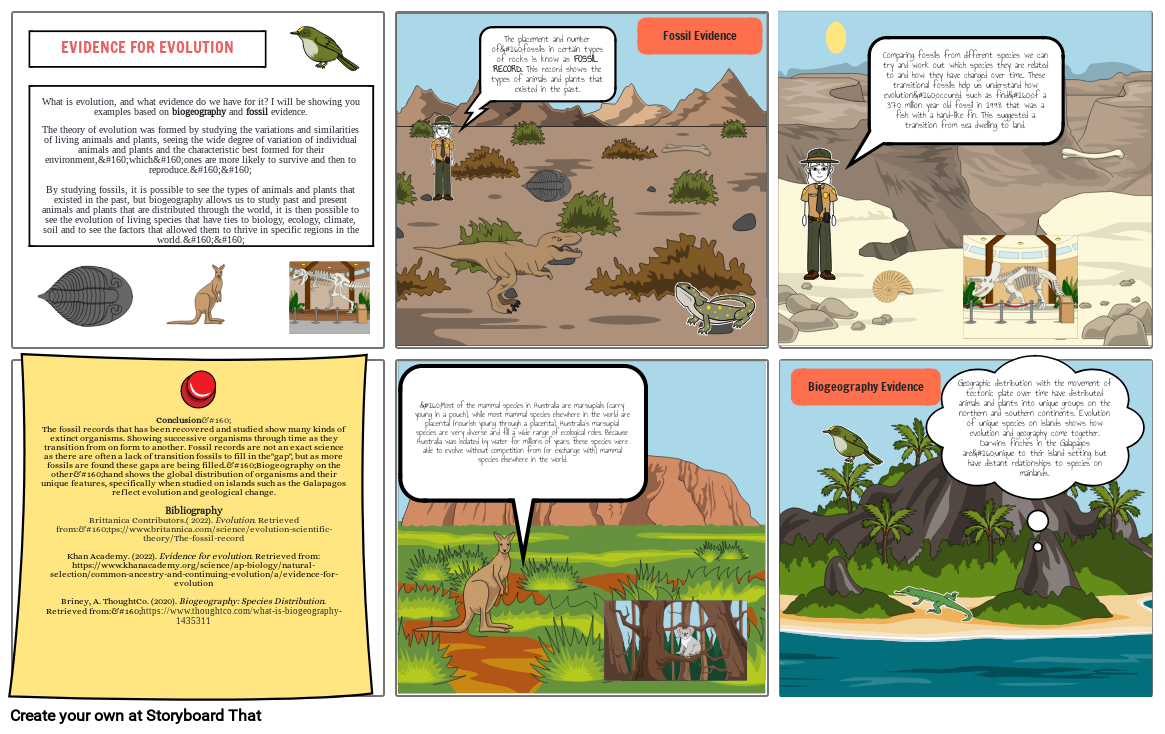Evidence for Evolution

Storyboard Text
- EVIDENCE FOR EVOLUTION What is evolution, and what evidence do we have for it? I will be showing you examples based on biogeography and fossil evidence. The theory of evolution was formed by studying the variations and similarities of living animals and plants, seeing the wide degree of variation of individual animals and plants and the characteristic best formed for their environment,whichones are more likely to survive and then to reproduce.By studying fossils, it is possible to see the types of animals and plants that existed in the past, but biogeography allows us to study past and present animals and plants that are distributed through the world, it is then possible to see the evolution of living species that have ties to biology, ecology, climate, soil and to see the factors that allowed them to thrive in specific regions in the world.
- The placement and number offossils in certain types of rocks is know as FOSSIL RECORD. This record shows the types of animals and plants that existed in the past.
- Fossil Evidence
- Comparing fossils from different species we can try and work out which species they are related to and how they have changed over time.. These transitional fossils help us understand how evolutionoccured, such as findof a 370 million year old fossil in 1998 that was a fish with a hand-like fin. This suggested a transition from sea dwelling to land.
- ConclusionThe fossil records that has been recovered and studied show many kinds of extinct organisms. Showing successive organisms through time as they transition from on form to another. Fossil records are not an exact science as there are often a lack of transition fossils to fill in thegap, but as more fossils are found these gaps are being filled.Biogeography on the otherhand shows the global distribution of organisms and their unique features, specifically when studied on islands such as the Galapagos reflect evolution and geological change.BibliographyBrittanica Contributors.( 2022). Evolution. Retrieved from:tps://www.britannica.com/science/evolution-scientific-theory/The-fossil-recordKhan Academy. (2022). Evidence for evolution. Retrieved from: https://www.khanacademy.org/science/ap-biology/natural-selection/common-ancestry-and-continuing-evolution/a/evidence-for-evolutionBriney, A. ThoughtCo. (2020). Biogeography: Species Distribution. Retrieved from:https://www.thoughtco.com/what-is-biogeography-1435311
- Most of the mammal species in Australia are marsupials (carry young in a pouch), while most mammal species elsewhere in the world are placental (nourish young through a placenta). Australia’s marsupial species are very diverse and fill a wide range of ecological roles. Because Australia was isolated by water for millions of years, these species were able to evolve without competition from (or exchange with) mammal species elsewhere in the world.
- Biogeography Evidence
- Geographic distribution with the movement of tectonic plate over time have distributed animals and plants into unique groups on the northern and southern continents. Evolution of unique species on islands shows how evolution and geography come together. Darwins finches in the Galapagos areunique to their island setting but have distant relationships to species on mainlands.
Over 30 Million Storyboards Created
No Downloads, No Credit Card, and No Login Needed to Try!
